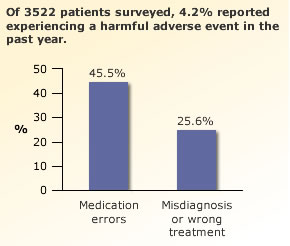Patient Engagement and Safety
Background
The traditional paternalistic model of medicine, in which patients have little voice in their care, has slowly but surely been evolving toward a model in which patients and clinicians work in a partnership toward the common goal of improved health. As articulated in the seminal Institute of Medicine report Crossing the Quality Chasm, such patient-centered care should be "respectful of and responsive to individual patient preferences, needs, and values and ensure that patient values guide all clinical decisions."
While many patient safety interventions have used traditional models of effecting change, such as changing provider behavior, encouraging interprofessional collaboration, and enhancing the culture of safety, the patient's role in safety has not been overlooked. The Joint Commission mandated that health care organizations "encourage patients' active involvement in their own care as a patient safety strategy" as a National Patient Safety Goal in 2007, catalyzing research into how patients may partner with providers to prevent errors–and how patients may themselves inadvertently precipitate errors.
Patients' Role in Preventing Errors
Efforts to engage patients in safety efforts have focused on three areas: enlisting patients in detecting adverse events, empowering patients to ensure safe care, and emphasizing patient involvement as a means of improving the culture of safety.
Hospitalized patients are routinely surveyed about their satisfaction with the care they received, and recent research has examined whether patient surveys may be used as an error detection mechanism. Studies in the inpatient setting have found that patients often report errors that were not detected through traditional mechanisms such as chart review; indeed, patient-reported errors formed the basis of landmark studies of adverse events after hospital discharge. Concerns have been raised, however, that patient complaints may center on poor service quality rather than on clinical adverse events.
Source: Adams RJ, Tucker G, Price K, et al. Self-reported adverse events in health care that cause harm: a population-based survey. Med J Aust. 2009;190:484-488. [go to PubMed]
Patients are also being encouraged to take an active role in their own safety. The Agency for Healthcare Research and Quality's Questions Are the Answer program and 20 Tips to Help Prevent Medical Errors fact sheet, as well as The Joint Commission's Speak Up initiative, are examples of programs that educate patients about safety hazards and provide specific questions that patients (and their caregivers) can ask regarding safety. Although patients have voiced concerns about engaging in behaviors that may seem confrontational (for example, asking their clinician if she washed her hands), some preliminary studies have found that active engagement of patients can improve adherence to safety practices. The widespread availability of electronic medical records is also being used as an opportunity to engage patients in safety efforts. Early studies have leveraged information technology to incorporate patients in medication reconciliation and early identification of outpatient adverse drug events.
Finally, hospitals are increasingly recognizing the crucial role of patients' perspectives in establishing a culture of safety. Many institutions (such as the Dana-Farber Cancer Institute) have prioritized engaging patient representatives in the design and nurturing of safety efforts, and emphasize transparency in reporting errors and care problems. The active engagement of patients in safety efforts has extended to allowing patients and families to summon rapid response teams, rather than waiting for clinicians to respond. Studies in the intensive care unit and inpatient pediatric wards have shown that interventions that explicitly include patient and family engagement can improve safety culture and may reduce adverse event rates.
Although patient engagement is a promising strategy for error reduction, there is reason for caution on several grounds. From a systems engineering viewpoint, the level of patient and family participation will always be difficult to predict, leading some to argue that a robust safety program should not depend on such engagement. Furthermore, patients and caregivers already shoulder a significant emotional burden for ensuring safety while hospitalized. An important study found that a surprising number of patients and family members feel guilty after a medical error, and another study found that most parents of hospitalized children felt personally responsible for ensuring their child's safety in the hospital. Engaging patients in error prevention therefore risks simply shifting the responsibility for safety from providers and institutions to patients themselves.
Patients' Role in Precipitating Errors
Patients themselves may be a cause of errors as well as a solution, and some early studies have sought to analyze and classify patient errors. These errors arise from the same underlying causes that contribute to clinicians' errors–while patients may engage in intentionally unsafe behavior, more commonly, patient errors are attributable to the difficulties inherent in an individual's interaction with a complex system. One study classified patient errors into action errors, which are errors of patient behavior such as failure to attend a scheduled appointment, and mental errors, which include thought process errors such as failing to take a medication as prescribed. Both of these types of error are influenced by other definable safety hazards; for example, low health literacy and poor provider–patient communication are clearly linked to medication errors. Therefore, a useful construct may be to view patient error as an undesirable outcome that clinicians should actively seek to prevent, using tools that target known risk factors for such errors. For example, lack of knowledge or fear of asking questions may cause patients to take medications incorrectly, but interventions such as pictogram-based medication labels can decrease dosing errors and improve medication adherence.
Current Context
Patient engagement in safety efforts is a strong priority of influential regulatory and governmental organizations. The Agency for Healthcare Research and Quality and the World Health Organization sponsor a variety of programs centered around patient education and encouraging patient perspectives to improve safety culture. In addition to its prioritization of patient engagement through the National Patient Safety Goal, The Joint Commission also provides educational resources for patients around safety measures in pediatric, hospital, and surgical settings.





